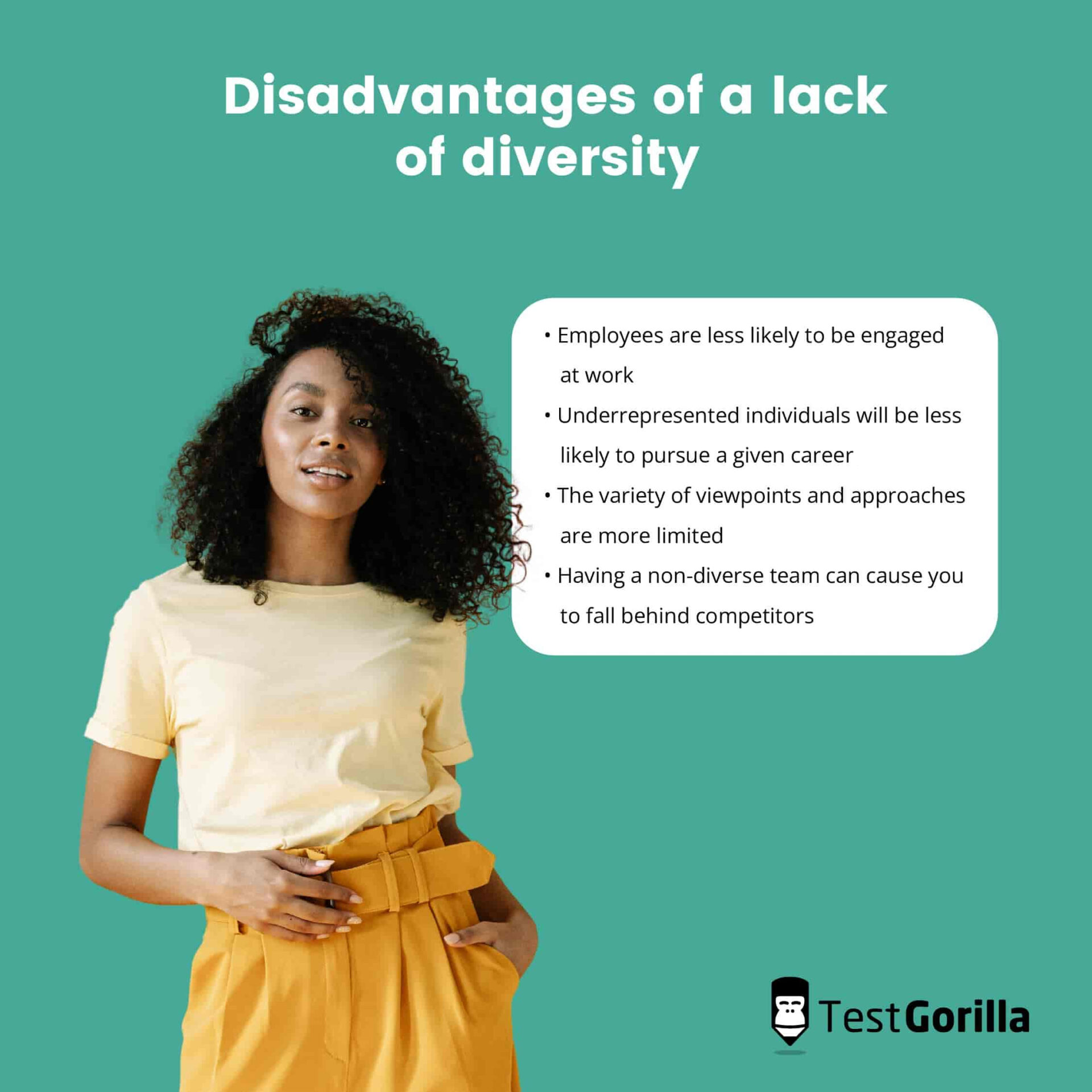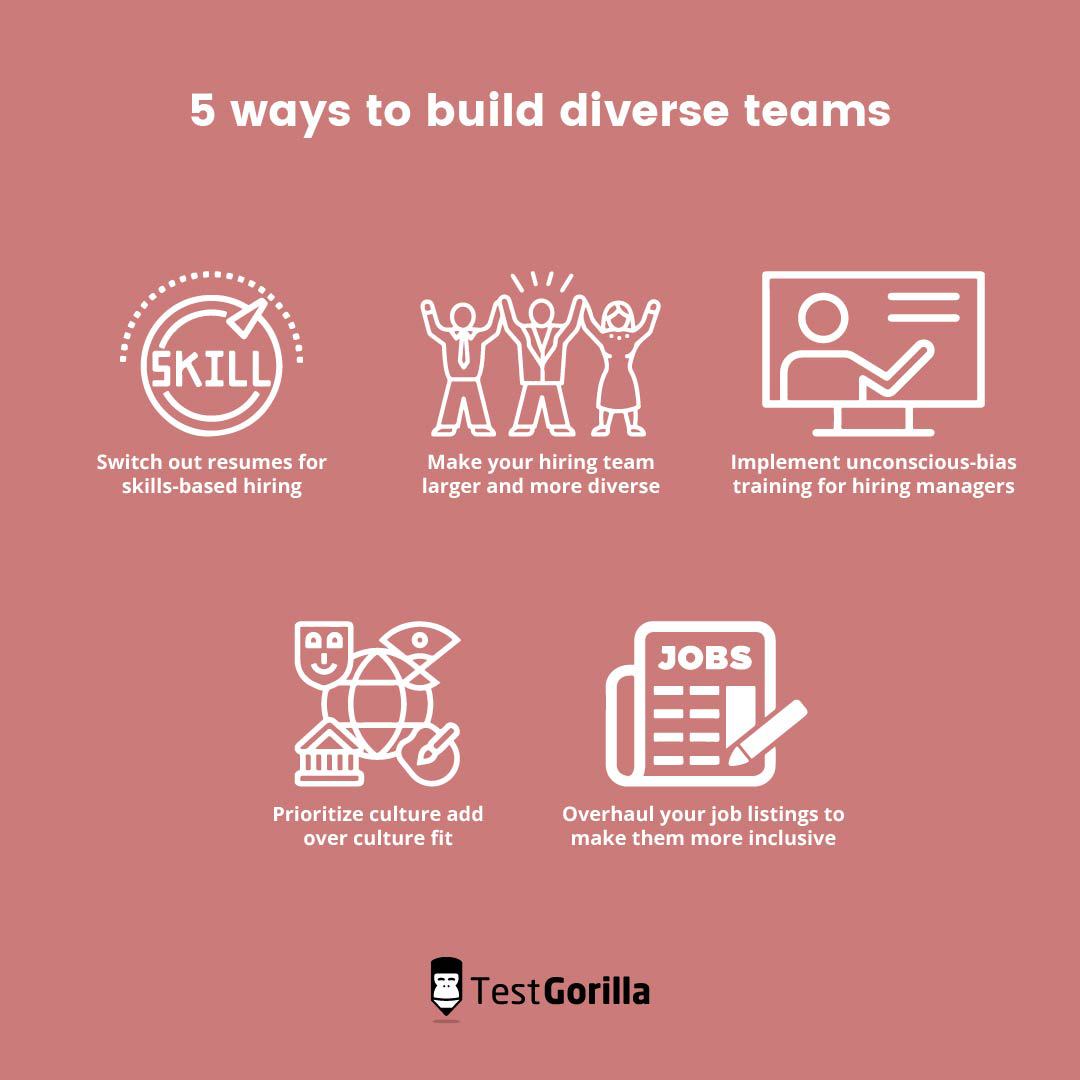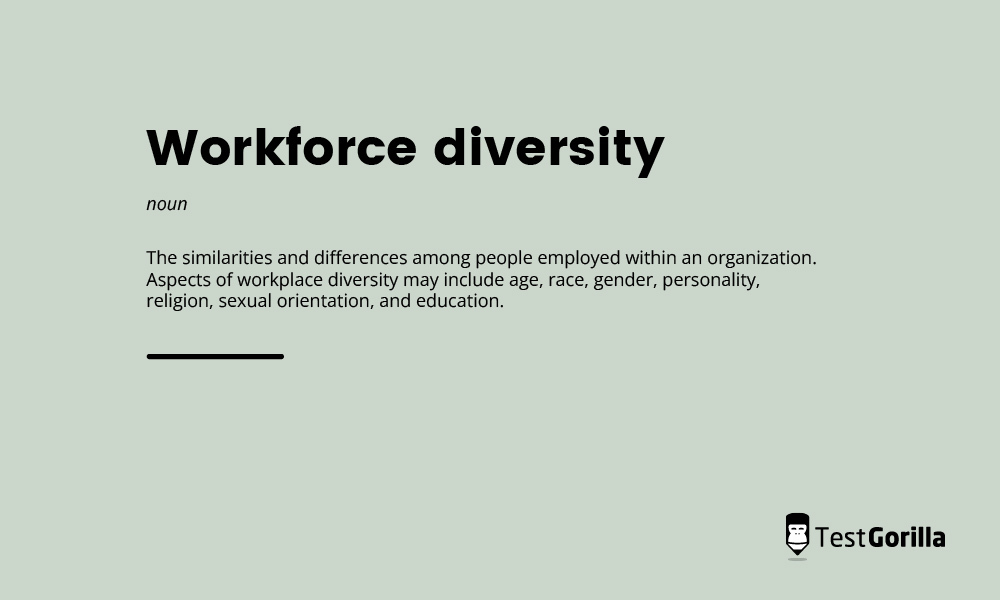Failing to hire for diversity can affect your business, reputation, and company culture.
In 2021, Amazon was hit with lawsuits over discriminating against female and Black applicants when hiring. That same year, Google paid out $2.6 million to people claiming its compensation and hiring practices discriminated against women and Asian people.
These multi-billion dollar corporations aren’t just losing out financially, their reputation has taken a blow and they’re missing out on the benefits of diversity and inclusion in the workplace.
Having a more diverse workforce is good for businesses and society as a whole. And focusing on inclusivity can transform your organization. From better employee retention to improved decision-making, the impact of diversity in the workplace is far-reaching.
In this post, we’ll share findings from our 2022 State of Skills-Based Hiring report and look at why, despite the well-known benefits of workplace diversity, some sectors are lagging behind.
We’ll also outline how a non-diverse workforce can hurt business performance, explore the benefits of diversity in the workplace, and share strategies for more inclusive hiring.
Table of contents
Why are some sectors less diverse?
When it comes to diversity, some industries do better than others. According to AdvisorSmith, which specializes in small business research and content, medical scientists and statisticians are the most diverse groups of highly-paid professionals.
But many other industries lag behind.
Which sectors are falling behind?
Currently, you’ll find little diversity among aircraft pilots, flight engineers, chemical engineers, and construction managers. Ninety-five percent of airline pilots in the US are male—and the vast majority are white.
And then there’s construction, which, in the UK, includes just 15% women and 6% Black, Indigenous, or People of Color (BIPOC). That country’s tech sector also has a serious diversity problem: only 19% of the workforce identify as women vs 49% of the workforce overall.
Women in North America are still drastically underrepresented in the financial services industry, especially at senior management level and above. And according to the World Economic Forum’s Global Gender Gap Report 2022, just one in five leadership roles in the energy sector are held by women.
What’s causing a lack of diversity in these professions?
So why is it that some sectors are falling so far behind in Diversity, Equity, and Inclusion (DE&I) initiatives? Well, there’s no one cause and the reasons can be complex and varied.
For some roles, like an airline pilot, training is long and expensive (you need 1,500 hours of experience to become a commercial pilot). And it doesn’t help when a young Black woman aspiring to the position has never seen anyone who looks like her in a cockpit. It’s more challenging for a child or young adult to imagine themself in a career when they’ve never seen anyone they can identify with doing the job.
And there are other, more tangible reasons behind the lack of diversity in certain industries, like outdated hiring practices rife with unconscious bias and hiring discrimination.
The landmark study “Are Emily and Greg more employable than Lakisha and Jamal? A field experiment on labor market discrimination” demonstrated that candidates with white-sounding names got 50% more callbacks for interviews than those with African-American names when resumes were exactly the same.
Even if it’s completely unintentional, interviewer bias can color decision-making and result in a homogenous workforce. And it’s easy for process bias – when your hiring biases prop up pre-existing biases in your organization – to lead to selecting new employees that are a mirror image of the existing workforce.
But a lack of diversity in a workforce isn’t just bad for candidates and DE&I initiatives, it can be bad for business.
Disadvantages of a lack of diversity
There are numerous disadvantages to having a non-diverse workforce, both for employees and for business performance. To begin, employees are less likely to be engaged at work when they believe their organization doesn’t foster an inclusive culture.
Additionally, low levels of diversity in an industry can turn into a vicious cycle, as a lack of role models means underrepresented individuals will be less likely to pursue a given career.
And when you have a homogenous team, you get homogenous ideas. When all your employees look and think the same and come from similar backgrounds, the variety of viewpoints and approaches they come up with are more limited. In their first ranking of corporate sectors and S&P 500 companies, the Wall Street Journal’s research analysts found that “Diverse and inclusive cultures are providing companies with a competitive edge over their peers”. So having a non-diverse team can cause you to fall behind competitors and an increasingly diverse, ever-evolving industry.
However, taking steps towards implementing a more inclusive, less biased hiring process can have a positive impact on business performance and employee morale.
Here’s how.
Why diverse hiring is good for business
When your team is more diverse, your business will flourish. Numerous studies demonstrate the positive impact and varied benefits of diversity in the workplace. For a start, greater cognitive diversity means faster problem-solving, better business decisions, and higher productivity.
McKinsey’s 2020 report “Diversity wins: How inclusion matters” found gender-diverse teams are 25% more likely to financially outperform less diverse companies, while ethnically diverse teams are 36% more likely to.
And a diverse workplace can make employees 5.4 times more likely to want to stay a long time at their company—given the costs of employee recruitment vs. retention, this can mean significant savings for your business.
Another positive impact of diversity in the workplace is higher quality output from employees. Max Armbruster, Founder and CEO of Talkpush, states that “Expanding your talent pool and considering a broader, wider range of candidates improves the quality of the output. If you have more input coming in, you have better quality coming out.”
5 ways to build diverse teams
The following tips can help you eliminate unconscious bias in your hiring process and build a high-performing diverse team.
1. Switch out resumes for skills-based hiring
Imagine if you could stop relying on outdated resumes and move towards a more inclusive way of hiring that leads to better results. You can, by implementing skills-based hiring.
Skills-based hiring lets you hire based on competencies that are directly related to a candidate’s ability to do a job, rather than relying on a resume that could be outdated or misleading. It also helps you eliminate elements that produce bias during the hiring process. For example, favoring a candidate based on the fact that they went to the same university as you rather than focusing on their relevant skills.
Skills-based hiring works by using targeted skills tests or assignments to measure candidates’ actual ability to perform in their potential roles. This reduces the possibility of bias creeping into your hiring process, meaning you can select people who are a better fit for the job. This levels the playing field for women, people of color (PoCs), neurodiverse candidates, etc., which helps build a more diverse team.
Our studies show that 91.1% of businesses saw an improvement in workplace diversity when they implemented skills-based hiring. And 42.9% of those businesses saw an increase of over 25%.
When you make skills-based hiring a pillar of your recruitment process, you can ensure you’re taking a more objective, accurate approach to hiring the best candidate possible for the position, regardless of their demographic, qualifications, or experience. And these efforts can have a positive impact on team performance. For example, when a Cape Town medical billing company called MedX implemented skills-based hiring with TestGorilla, they saw a significant improvement in the quality of their new hires.
2. Make your hiring team larger and more diverse
When you implement skills-based hiring alongside other practices to help overcome unconscious bias in the recruitment process, you’re more likely to improve diversity in the workplace.
We’ve found that the total percentage of respondents experiencing positive improvements in workplace diversity increases from 80.2% to 92.62% when one other practice to reduce unconscious bias is introduced on top of skills-based hiring.
That number jumps up to 97.59% for organizations that introduced three additional practices to reduce unconscious bias on top of skills-based hiring.
One effective practice is expanding your hiring team and making it more diverse. When you involve more people in the decision-making process, it reduces the chances of one person’s bias having a disproportionate impact.
Also, be sure your hiring team is diverse: if you don’t want all your hires to look, think, and act the same, your hiring team shouldn’t either.
3. Implement unconscious-bias training for hiring managers
As mentioned earlier, coupling skills-based hiring with other practices can make diversity recruiting much more effective. That’s why regular implicit bias training should form an integral part of your hiring managers’ role.
When people are aware of their biases, they’re more likely to be able to identify and avoid them in practice.
But one-off training sessions won’t cut it.
Unconscious-bias training requires commitment, thought, time, and effort. It should be an engaging activity that requires critical thinking from participants, and training material should be updated regularly.
And it isn’t just a box to check, so don’t treat it as such. When you put enough energy and resources into truly reducing your hiring managers’ biases, it pays off in your efforts to create a more diverse workplace.
4. Prioritize culture add over culture fit
Culture fit is a well-worn term in hiring conversations. But we’re here to tell you it’s not the right way to select your candidates. Look for culture-add instead.
Culture add focuses on adding unique perspectives and ways of thinking to your team. By contrast, hiring for culture fit can result in a non-diverse team and even underqualified candidates. When you prioritize candidates that “fit” with your culture, you’re missing out on the opportunity to work with people who bring fresh perspectives. And they could even be more competent than someone hired on the basis of culture fit.
Taking a culture-add approach also helps your company and culture evolve as new players with fresh ideas and perspectives join your team.
Compare that to the issues of hiring for culture fit, which makes it more likely bias from hiring managers will creep in during the recruitment process and can result in stagnation caused by poor innovation and a lack of unique perspectives among team members.
5. Overhaul your job listings to make them more inclusive
You can lay the groundwork for a more diverse team before you even speak to any candidates by rewording your job listings to be more inclusive. Even without realizing it, you could be including language that has an underlying bias against BIPOC candidates.
Or you may be using gender-coded language in your job description that implicitly discourages women from applying to your position. For example, if you describe the role as “salesman” instead of “salesperson.”
Use language that is as role-specific and inclusive as possible, and always favor non-binary pronouns (they/them) over binary ones (he/she).
You can use a tool like Textio to identify and remove words with underlying bias. Be sure to test out your copy with a diverse group of people to make sure there isn’t any language that could be misinterpreted or seen as offensive by a particular demographic.
Workforce diversity: the key to transforming your business and reputation
In major sectors like the financial and energy industries, workplace diversity has a long way to go. By ignoring the importance of having unique and diverse employees you don’t just make your organization less desirable for employees and potential candidates, you also hurt your business.
But when you make equal opportunity one of your organization’s values, you’ll help contribute to a more equitable workplace and industry while enjoying improved productivity and performance throughout your company.
Adopt skills-based hiring practices along with other practices that promote inclusion through your hiring process. For example, employing a larger and more diverse hiring team and publishing more inclusive job listings.
Together, these measures will help you select the right people for the job based on skills, not their connections, education, or experience. And that helps create a workplace employees are proud to form a part of and a business that thrives thanks to unique and varied perspectives.
Diversity isn’t just a box to check—it can benefit your employees and your business. Discover how a more diverse team benefits your business, reputation, and performance. Download the State of Skills-Based Hiring Report.
Related posts
Hire the best candidates with TestGorilla
Create pre-employment assessments in minutes to screen candidates, save time, and hire the best talent.
Latest posts
The best advice in pre-employment testing, in your inbox.
No spam. Unsubscribe at any time.

Hire the best. No bias. No stress.
Our screening tests identify the best candidates and make your hiring decisions faster, easier, and bias-free.
Free resources
This checklist covers key features you should look for when choosing a skills testing platform
This resource will help you develop an onboarding checklist for new hires.
How to assess your candidates' attention to detail.
Learn how to get human resources certified through HRCI or SHRM.
Learn how you can improve the level of talent at your company.
Learn how CapitalT reduced hiring bias with online skills assessments.
Learn how to make the resume process more efficient and more effective.
Improve your hiring strategy with these 7 critical recruitment metrics.
Learn how Sukhi decreased time spent reviewing resumes by 83%!
Hire more efficiently with these hacks that 99% of recruiters aren't using.
Make a business case for diversity and inclusion initiatives with this data.






















